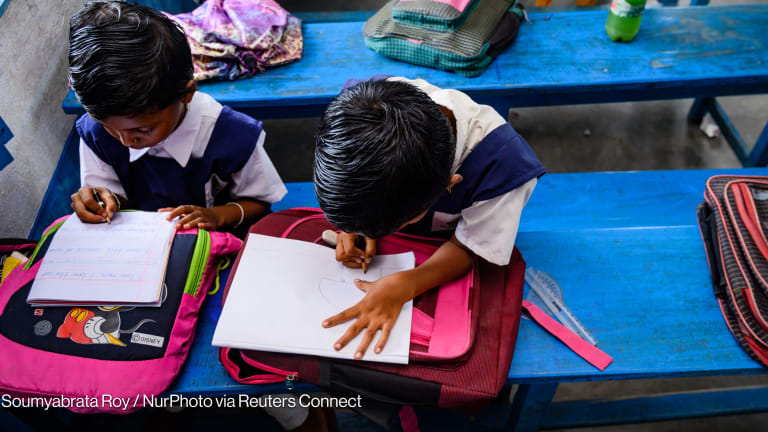
Earlier this month in Mexico City, I joined more than 1,300 representatives of governments, multilateral agencies, civil society organizations, private sector companies and a few philanthropic foundations at the anxiously anticipated first high-level meeting of the Global Partnership for Effective Development Cooperation.
The partnership aims to bring state and non-state actors together to eradicate poverty through better cooperation. In development shorthand, its provenance comes via commitments made in Paris, Accra and most recently the aid effectiveness high watermark in Busan, South Korea in 2011.
Early aspirations for the Mexico meeting concentrated on pushing the partnership out of Busan’s long shadow and into the post-2015 spotlight — offering a confident aid effectiveness model with real political momentum for the new development world order.
Though this initial ambition seemed to temper in the weeks and days leading up to the GPEDC conference itself — indeed, save for a Ban Ki-moon cameo, Mexico City felt more “conference” than “summit” — there were moments of clarity and optimism about exactly what added value the GPEDC brings to the global development dialogue.
A seat at the table
I would wager that a mutual ambivalence left the philanthropic community unnoticeably absent in Busan three years ago.
Mexico City, however, was different. With the help of netFWD — a membership network of foundations housed by the Organization for Economic Cooperation and Development — in navigating the layers of multilateral development bureaucracy, foundations were invited onto the GPEDC Steering Committee and given a literal seat at the table. Indeed, Stars Foundation was the first philanthropic organization to fill the seat.
But the gospel of aid processes like this one — transparency, accountability and alignment — is unfamiliar to most foundations. Indeed, we are a bafflingly heterogeneous sector, eschewing standardisation and fiercely guarding our independence.
Such characteristics of modern philanthropy raised questions about whether or not foundations could ever play a meaningful role in the choreographed, norm-based development cooperation the GPEDC was to roll out. Then again, similar tensions produced much sharper edges in the move to endorse the private sector’s role in the GPEDC’s cooperation experiment.
And whereas Mexico failed to clarify any definitive standards for private sector to engage in aid, foundations offered up a set of guidelines that would encourage them to comply with more traditional development principles.
Introducing guidelines
Presented as a framework for more strategic foundation involvement in international development processes — particularly in our interactions with governments — the Guidelines for Effective Philanthropic Engagement were developed under the leadership of netFWD, with support from Worldwide Initiatives for Grantmaker Support — known as WINGS, the European Foundation Centre, the U.N. Development Program, the Rockefeller Foundation and colleagues at Stars.
Offering a way for philanthropy to engage in greater dialogue, reduce opacity of their activities, share lessons and partner more effectively, the guidelines target the government-foundation relationship because we recognize that state actors set the policy environment we and our partners operate in, and because they remain best placed to ensure long-term sustainability and scale of the impact of our efforts.
The guidelines were introduced in a dedicated focus session on the first day of the Mexico forum, where my peers on the panel reflected on both the substance of the document and the symbolism of foundations being brought into the fold.
Overwhelmingly, they saw the guidelines as the right "mood music" to bring together foundations and governments to foster mutual understanding and — most importantly — to focus on comparative advantages.
Complementarity, complexity
Philanthropic privileges are many — there is less handwringing over financial concerns, we are meant to have a larger appetite for risk, are capable of longer-term and swifter interventions, allowed to reinvent ourselves almost at a whim and to "fail" in the name of experimentation, learning and innovation.
But in order to actually accelerate development practice, foundations must strategically leverage those assets while allowing partners — CSOs, government actors and even the private sector — to leverage theirs.
This will be a challenge. Cooperation is not easy — especially among unfamiliar partners — and transaction costs are high. But this kind of multi-stakeholder approach is the only chance we have at meeting the next set of global development targets.
The guidelines may fall short in some places — the language has been criticized for being at once too vague for some and too prescriptive for others — but their very existence echoes a critical insight of the entire GPEDC project itself: We can do more if we do more together.
Building bridges
The spirit and way in which foundations have entered this arena is a model for how the GPEDC’s multiple stakeholders should engage with each other moving forward.
Foundations recognize their differences — with each other, with other development actors — but have chosen instead to focus on what we have in common, using the guidelines to reflect on our collective practice and identify the most salient areas in which we could modify behavior to fit into the wider development ecosystem.
Those that have signed up to the partnership must now do the same: To embrace the common agenda rather than retreating to the more parochial ones.
Of course, this is easier said than done and the asymmetry in power dynamics at the forum was palpable — technical discussions from the podium inevitably giving way to discussions of politics and power from the floor, with foundations sitting, rather uncomfortably at times, in the middle.
Steering the ship
Just as the guidelines will now focus on specific country pilots — we expect the first to take place in Mexico, a fitting move with Mexico as one of the three new GPEDC co-chairs — I urge the steering committee to do the same: To employ a bit of nominative determinism and start steering the partnership toward the tangible.
There is strength in the GPEDC’s diversity, but — and I know this sounds rich coming from the “new kids on the block” — inclusivity isn’t about the process or how the seats are arranged at the table. It’s about the outcome.
The real test of the GPEDC will be in whether or not we can truly measure collective good out of the country-level experiments that are now expected to take shape.
Join the Devex community and access more in-depth analysis, breaking news and business advice — and a host of other services — on international development, humanitarian aid and global health.
See more:
GPEDC told to push traditional donors, 'nudge' new ones on transparency
3 tests for the Global Partnership
GPEDC high-level meeting to push Busan agenda even further
Financing the future: Why domestic revenue mobilization belongs on the post-2015 agenda
Boosting economic development: Real aid to the private sector
How to make development cooperation more effective in Asia-Pacific
We must seize the opportunity of the First High-Level Meeting of the Global Partnership for Effective Development Cooperation








